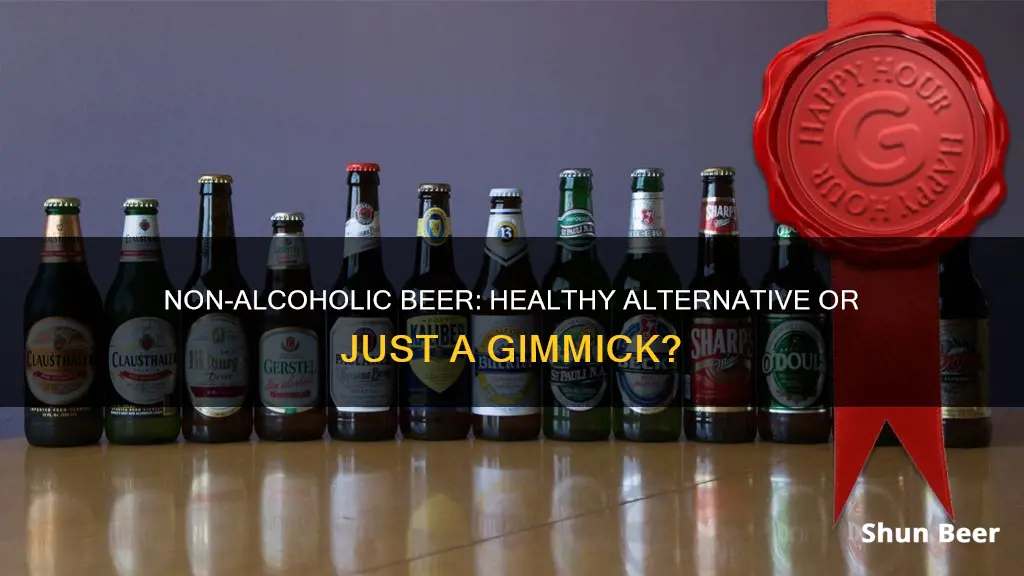
Non-alcoholic beer is often marketed as a safe alternative to alcoholic drinks, but it is important to be aware of the risks before consuming it. While non-alcoholic beer may be a good option for some people, it can be dangerous for certain populations, such as pregnant people and those with alcohol use problems.
Non-alcoholic beer is a type of beer that contains very little or no alcohol, usually produced by removing the alcohol from regular beer. However, it is important to note that non-alcoholic beers can still contain up to 0.5% alcohol by volume (ABV) and may not be completely alcohol-free. The amount of alcohol in these products can vary, so checking the labels before consuming them is essential.
One of the potential dangers of non-alcoholic beer is that it may still contain small amounts of alcohol, which can be harmful to certain individuals. Additionally, research suggests that many non-alcoholic beers contain more alcohol than their labels indicate, with some studies finding higher alcohol levels than advertised. For individuals with liver impairments, consuming non-alcoholic beer may result in higher blood alcohol levels than normal.
Another concern is the smell and taste of non-alcoholic beer, which can be triggering for people with alcohol use disorder. The smell of beer may evoke memories of drinking and trigger cravings, potentially leading to a relapse. According to statistics, a significant percentage of alcoholics will experience a relapse within a few years of quitting.
Furthermore, non-alcoholic beer should be avoided by pregnant individuals as it may contain unsafe amounts of alcohol. According to medical organizations, pregnant people should avoid consuming any alcohol to prevent fetal alcohol spectrum disorder (FASD) and other birth defects.
While non-alcoholic beer can be a safer option for those looking to reduce their alcohol intake, it is crucial to consider the potential risks associated with it. For individuals who are pregnant, trying to conceive, or have a history of alcohol use problems, it is generally recommended to avoid non-alcoholic beers.
| Characteristics | Values |
|---|---|
| Alcohol content | Non-alcoholic beer is often presented as a safe alternative to alcohol, but it may still contain small amounts of alcohol. By law, non-alcoholic beers can have up to 0.5% alcohol by volume (ABV) in the US. |
| Health benefits | Non-alcoholic beer has fewer calories than regular beer. It may also have anti-inflammatory properties and reduce the risk of cardiovascular disease. |
| Risks | Non-alcoholic beer may be triggering for people with alcohol use disorder or those who are pregnant. It may also contain more alcohol than advertised. |
What You'll Learn

Non-alcoholic beer and addiction recovery
Non-alcoholic beer is often marketed as a safe alternative to regular beer. While it may be a good option for some, it can be dangerous for those with alcohol problems or who are pregnant. For people in recovery from alcohol addiction, non-alcoholic beer can be a tricky area.
Non-alcoholic beer is a beverage that is designed to taste, look, and smell like traditional beer but contains very little or no alcohol. It is usually produced by removing most of the alcohol from regular beer, and the amount remaining varies. While federal law in the US states that non-alcoholic beers can have up to 0.5% alcohol by volume (ABV), many contain more alcohol than their labels indicate. Some studies have found that non-alcoholic beers can contain up to 1.8% ABV, and even this small amount of alcohol can be dangerous for people in recovery.
For individuals in recovery from alcohol addiction, non-alcoholic beer can be a helpful tool to navigate social situations and feel included without consuming alcohol. It can provide a sense of normalcy and help them enjoy the taste and experience of beer while maintaining their sobriety. However, it is important to note that non-alcoholic beer may still trigger cravings or emotional associations related to past drinking experiences. The smell and taste of non-alcoholic beer may be enough to trigger a relapse for some individuals.
The decision to consume non-alcoholic beer during recovery is a personal one and depends on various factors. Each person in recovery must consider their unique circumstances, triggers, and goals. Consulting with healthcare professionals, therapists, or support groups is essential to making an informed decision. Some sobriety coaches and recovering alcoholics advocate for complete abstinence from non-alcoholic beer, while others view it as a harm-reduction tool when consumed responsibly.
Overall, while non-alcoholic beer can be a viable alternative for some individuals in recovery, it is crucial to weigh the risks and benefits carefully. Understanding one's triggers and staying vigilant are essential to maintaining long-term sobriety.
Beer and Gout: What's the Connection?
You may want to see also

Non-alcoholic beer and pregnancy
Non-alcoholic beer is a beer that contains less than 0.5% alcohol by volume (ABV). This means that non-alcoholic beer can legally contain a small amount of alcohol, and some products may contain more alcohol than advertised. For example, a 2010 study found that 29% of the beverages it tested had higher ethanol levels than stated on the label, with some beverages containing up to 1.8% ethanol.
There is limited research on the safety of consuming non-alcoholic beer during pregnancy. The American College of Obstetrics and Gynecology (ACOG) states that no amount of alcohol during pregnancy is considered safe, as it is linked to behavioral and learning difficulties, birth defects, fetal alcohol spectrum disorder (FASD), and other risks. The ACOG, the Centers for Disease Control and Prevention (CDC), and the American Academy of Pediatrics (AAP) agree that zero alcohol should be consumed during pregnancy, including "non-alcoholic" drinks that contain 0.5% alcohol or less.
Some experts suggest that the trace amounts of alcohol in non-alcoholic beer are similar to the amount of naturally occurring alcohol found in some foods and drinks, such as fruit juice and ripe bananas. However, it is important to note that alcohol is also present in everyday food items such as burger buns, which can contain upwards of 1.3% ABV.
The decision to consume non-alcoholic beer during pregnancy is a personal one and should be made in consultation with a healthcare provider. While some sources suggest that the small amount of alcohol in non-alcoholic beer is likely safe, others recommend complete abstinence from alcohol during pregnancy to eliminate any risk of fetal alcohol spectrum disorder.
If you are looking for a non-alcoholic drink to enjoy during pregnancy, alcohol-free drinks that contain zero detectable alcohol are generally considered a safer option. However, it is important to read labels carefully and check with your doctor, as some non-alcoholic drinks may contain ingredients that are not recommended during pregnancy.
Expired Beer: Safe to Drink or Not?
You may want to see also

Non-alcoholic beer and health
Non-alcoholic beer is often marketed as a healthier alternative to alcoholic beer, but it is important to be aware of the potential risks before consuming it. While non-alcoholic beer typically contains very little alcohol, some products may have higher alcohol levels than advertised, which can pose risks for certain individuals.
Nutritional Value
Non-alcoholic beer has little nutritional value and consists mostly of carbohydrates, similar to regular beer. However, it tends to be lower in calories, which can be beneficial for weight management.
Health Benefits
Non-alcoholic beer may offer some health benefits, such as reduced inflammation and a lower risk of common colds. It has also been found to be effective as a recovery beverage after exercise and has been embraced by some Olympic athletes as a sports drink. Additionally, removing alcohol from beer eliminates a toxic compound that increases the risk of chronic diseases.
Risks and Considerations
One of the main risks associated with non-alcoholic beer is its potential to trigger cravings and relapse in individuals with alcohol use disorders. The smell, taste, and appearance of non-alcoholic beer can evoke memories of drinking and lead to a relapse. This effect may be particularly strong for those in early recovery, and it is recommended that individuals with a history of alcohol misuse avoid non-alcoholic beer.
Non-alcoholic beer may also be unsafe for pregnant individuals as it may contain small amounts of alcohol. According to the American College of Obstetrics and Gynecology (ACOG), pregnant individuals should avoid any alcohol consumption to prevent fetal alcohol spectrum disorder (FASD).
Furthermore, non-alcoholic beer may not be a suitable alternative for individuals with liver impairments, as it can cause higher blood alcohol levels and lead to positive alcohol tests.
Recommendations
When considering non-alcoholic beer, it is essential to weigh the potential benefits against the risks. Individuals with a history of alcohol misuse, those who are pregnant or trying to conceive, and those with liver impairments should generally avoid non-alcoholic beer. For others, it may be a safer alternative to regular beer, but it is still important to consume it in moderation and be mindful of the potential risks.
Kicking the Beer Habit for Weight Loss
You may want to see also

Non-alcoholic beer and social situations
Non-alcoholic beer is often presented as a safe alternative to alcohol, but it is important to be aware of the risks before trying it. It may seem like a great choice if you are trying to limit your alcohol consumption since non-alcoholic beer often smells and tastes similar to alcoholic beers. However, there are dangers of non-alcoholic beer that should be considered, particularly for those with alcohol problems and pregnant people.
Non-alcoholic beer can be a great option for people looking to reduce their alcohol intake while still being able to enjoy the taste and experience of beer. It can be especially useful in social situations where alcohol is often consumed, such as parties or dinners. For people who are trying to cut back on their drinking, it can be a way to still feel included in social gatherings without compromising their sobriety.
However, it is important to note that non-alcoholic beer may not be suitable for everyone. For individuals with a history of alcohol use problems, the smell and taste of non-alcoholic beer may trigger cravings and increase the risk of relapse. In such cases, it may be best to avoid non-alcoholic beer and opt for other non-alcoholic beverages.
Additionally, it is important to check the labels of non-alcoholic beers before consuming them. While products marketed as alcohol-free are required to contain 0.0% ABV, non-alcoholic beers can legally have up to 0.5% alcohol by volume (ABV). This means that consuming a significant amount of non-alcoholic beer could still result in a small amount of alcohol intake.
In social situations, it is essential to be mindful of your triggers and boundaries. If you feel comfortable drinking non-alcoholic beer and it does not interfere with your recovery, it can be a great option to have. However, if you feel that it may trigger cravings or compromise your sobriety, it is best to avoid it.
Overall, the decision to drink non-alcoholic beer is a personal one and should be based on an individual's comfort level and recovery journey. It is crucial to prioritize your sobriety and well-being above all else.
Breastfeeding and Alcohol: Beer and Wine – Safe or Not?
You may want to see also

Non-alcoholic beer and taste
Non-alcoholic beer has often been criticised for its taste, with some people finding it flat and watery. This is because the process of removing alcohol from beer can also kill the aroma from hops, which gives regular beer its unique flavour. However, researchers at the University of Copenhagen have recently developed a new method of brewing non-alcoholic beer that tastes just like regular beer. This method involves producing monoterpenoids, the compounds responsible for the hoppy flavour of regular beer, and adding them to the non-alcoholic beer at the end of the brewing process. This new technique is also much more sustainable than existing brewing techniques.
Non-alcoholic beers are often marketed as a healthier alternative to regular beer, and this is true in some ways. Removing the alcohol from beer eliminates a toxic compound that increases the risk of chronic disease. Non-alcoholic beers also tend to be lower in calories than regular beers. However, most non-alcoholic beers offer very little nutritional value and are mostly carbohydrates. They also often contain added sugar or high-fructose corn syrup, which can make them cloyingly sweet.
It is important to note that non-alcoholic beers are not completely free of alcohol. By law, non-alcoholic beers can contain up to 0.5% alcohol by volume (ABV). Additionally, research has found that many non-alcoholic beers contain more alcohol than their labels indicate. This can pose a risk to pregnant people and those with alcohol use problems, as even small amounts of alcohol can be harmful to these individuals. The smell and taste of non-alcoholic beer may also trigger cravings and subsequent relapses in people with alcohol use disorder.
Skunked Beer: Is It Safe to Drink?
You may want to see also
Frequently asked questions
No. Non-alcoholic beer may still contain small amounts of alcohol, and the American College of Obstetrics and Gynecology (ACOG) recommends that pregnant people avoid drinking any alcohol to avoid the risk of fetal alcohol spectrum disorder (FASD).
It depends. For some people, non-alcoholic beer can be a helpful way to reduce their alcohol intake. However, for others, the taste and smell of non-alcoholic beer may trigger cravings and lead to a relapse. It's important to know your triggers and make an informed decision about what's best for your recovery.
Non-alcoholic beer typically has fewer calories than regular beer, but it also offers very little nutritional value and is mostly carbohydrates. It's important to read the labels and be mindful of any added sugar.







